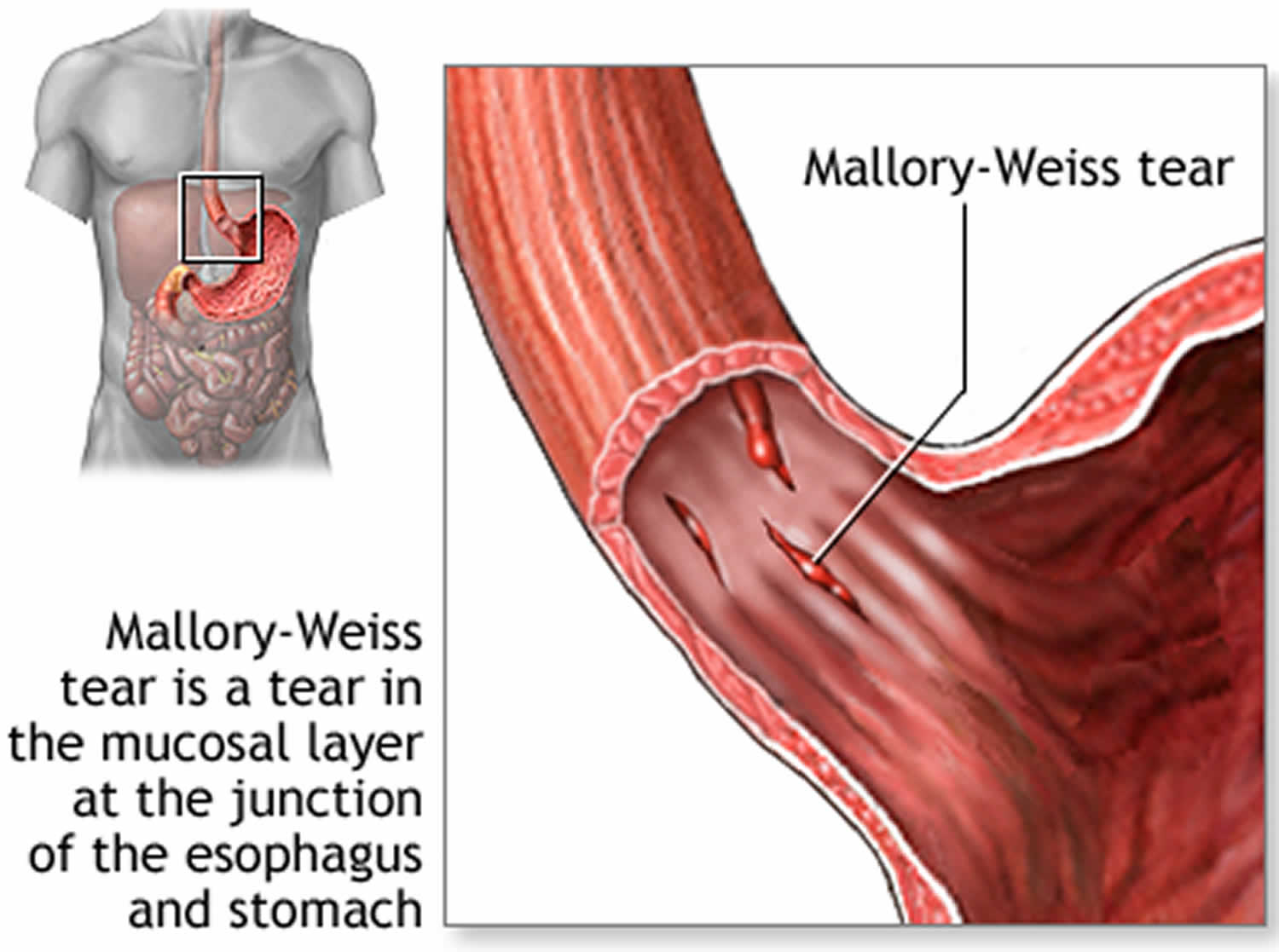Contents
What is Mallory Weiss syndrome
Mallory Weiss syndrome is more commonly known as Mallory-Weiss tear, which is a tear the tissue of your lower esophagus caused by forceful vomiting and are typically located at the gastroesophageal junction 1. Your esophagus is the tube that carries food from your throat to your stomach. It plays a vital role in digestion. Sometimes, a tear the tissue of your lower esophagus and it can start to bleed. The condition is called a Mallory-Weiss tear.
Mallory Weiss syndrome (Mallory-Weiss tear) is most often caused from forceful or long-term vomiting or coughing. Mallory Weiss syndrome (Mallory-Weiss tear) may also be caused by epileptic convulsions. Less common causes are a hiatal hernia, or childbirth, which can increase pressure in your abdomen.
Any condition that leads to violent and lengthy bouts of coughing or vomiting can cause these tears.
Mallory Weiss syndrome (Mallory-Weiss tear) accounts for 3% to 15% of people with upper gastrointestinal (GI) bleed 1.
The bleeding is usually self-limited, ceasing spontaneously in 80% to 90% of patients 1. The pathogenesis is not completely understood. However, most patients report an Mallory Weiss syndrome (Mallory-Weiss tear) after an event that provokes a sudden rise in the pressure gradient across the gastroesophageal junction, such as retching, vomiting, coughing, or straining. Retching is also called dry vomiting—trying to vomit but having nothing come out of your mouth.
Repeated bleeding is uncommon and the outcome is most often good. Cirrhosis of the liver and problems with blood clotting make future bleeding episodes more likely to occur.
Key points
- A Mallory Weiss syndrome (Mallory-Weiss tear) is a tear of the tissue of your lower esophagus.
- Mallory Weiss syndrome (Mallory-Weiss tear) is most often caused by violent coughing or vomiting.
- A Mallory-Weiss tear can be diagnosed and treated during an endoscopic procedure.
- Mallory Weiss syndrome (Mallory-Weiss tear) usually heals in a few days without treatment.
- The tear may also be fixed by clips that are put in during an endoscopy. Surgery is rarely needed. Drugs that suppress stomach acid (proton pump inhibitors or H2 blockers) may be given, but it is not clear if they are helpful.
- If the tear is not treated, it can lead to anemia, fatigue, shortness of breath, and even shock.
- If blood loss has been great, blood transfusions may be needed. In most cases, bleeding stops without treatment within a few hours.
Mallory Weiss syndrome symptoms
It can be hard to tell that you have a Mallory Weiss syndrome (Mallory-Weiss tear) and that you are bleeding inside. But, you may have some of these signs and symptoms:
- Vomit that is bright red or that looks like coffee grounds
- Black or tar-like stools
- Stools with blood present
- Weakness, dizziness, faintness
- Shortness of breath
- Diarrhea
- Paleness
- Abdominal or chest pain
Blood in your vomit or stool is a serious symptom that calls for urgent medical attention. If you notice any of the symptoms of a Mallory-Weiss tear, contact your healthcare provider right away.
What are the complications of a Mallory Weiss syndrome?
In rare instances, a Mallory Weiss syndrome (Mallory-Weiss tear) leads to severe internal bleeding. You get a rapid pulse, a drop in blood pressure, problem producing urine, and shock. If bleeding goes untreated, it may result in anemia with fatigue, and shortness of breath.
Can a Mallory-Weiss syndrome be prevented?
There isn’t a lot you can do to prevent a Mallory-Weiss tear. Avoiding situations that cause violent vomiting (such as the stomach flu) or coughing (such as smoking), can help lessen your risk.
How is a Mallory-Weiss syndrome diagnosed?
If you have symptoms of a Mallory Weiss syndrome (Mallory-Weiss tear), your healthcare provider may check your stool for blood. Your doctor may also do an esophagogastroduodenoscopy. For this test, your doctor inserts a flexible tube through your mouth, down into your esophagus. A camera at the end of the tube lets the doctor to see the tear inside of your esophagus.
Mallory Weiss syndrome treatment
A Mallory Weiss syndrome (Mallory-Weiss tear) will stop bleeding and begin to heal on its own in most cases in a few days. Sometimes you will need treatment. An endoscope may be used to give you an injection or a heat treatment to stop the bleeding, or insert a clip that closes the tear and stops the bleeding.
The tear usually heals in a few days without treatment. The tear may also be fixed by clips that are put in during an endoscopy. Surgery is rarely needed. Drugs that suppress stomach acid (proton pump inhibitors or H2 blockers) may be given, but it is not clear if they are helpful.
If blood loss has been great, blood transfusions may be needed. In most cases, bleeding stops without treatment within a few hours.





